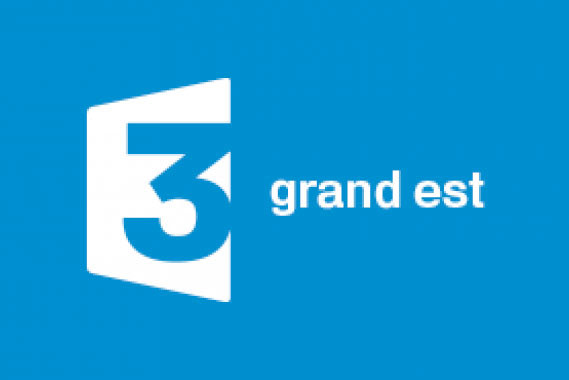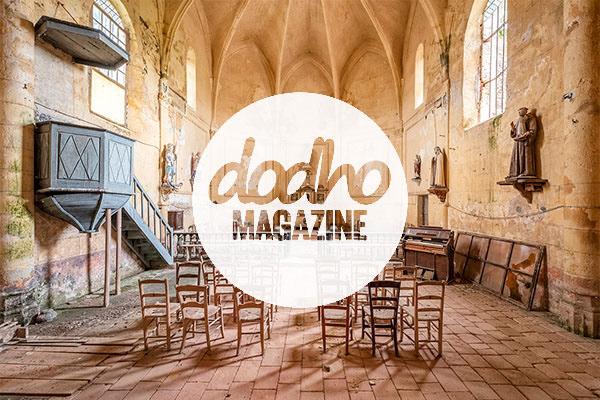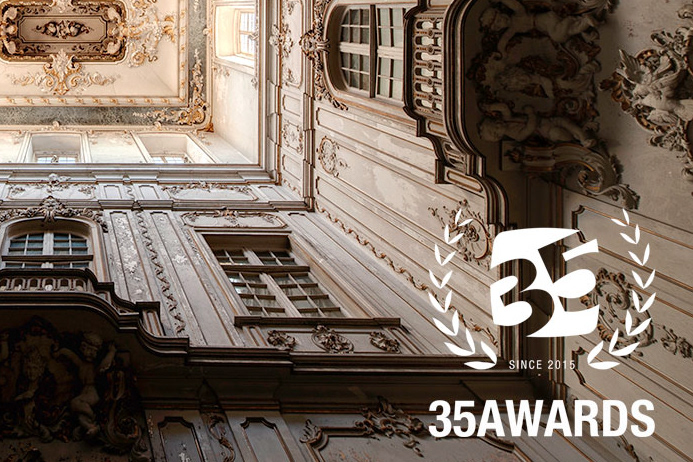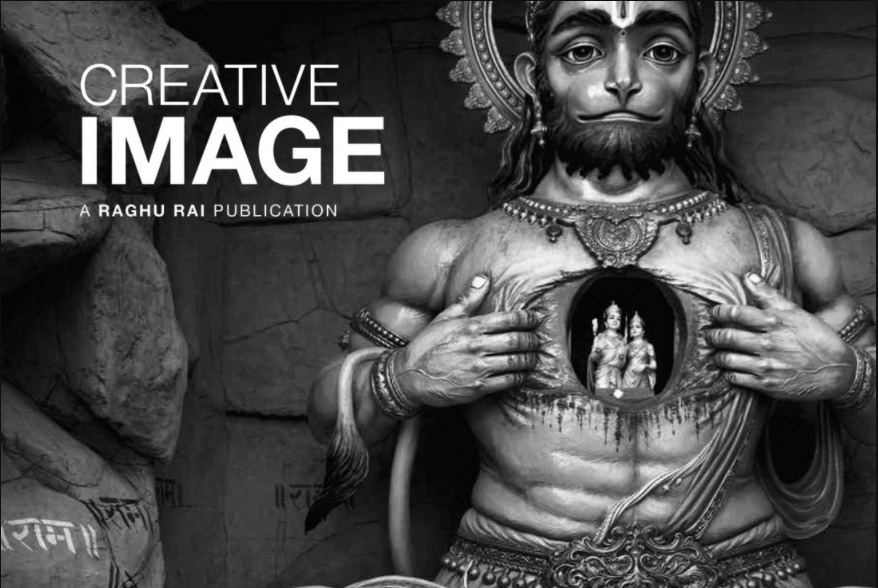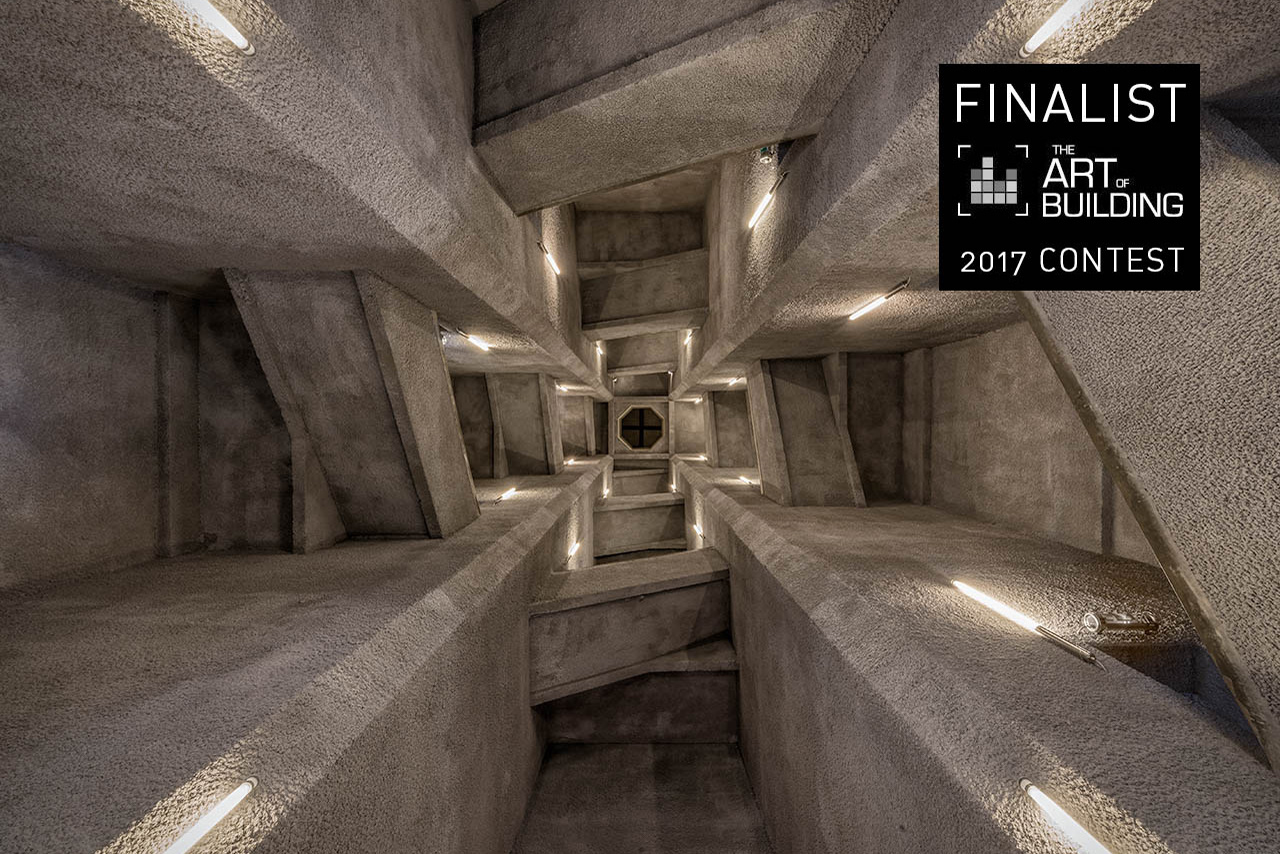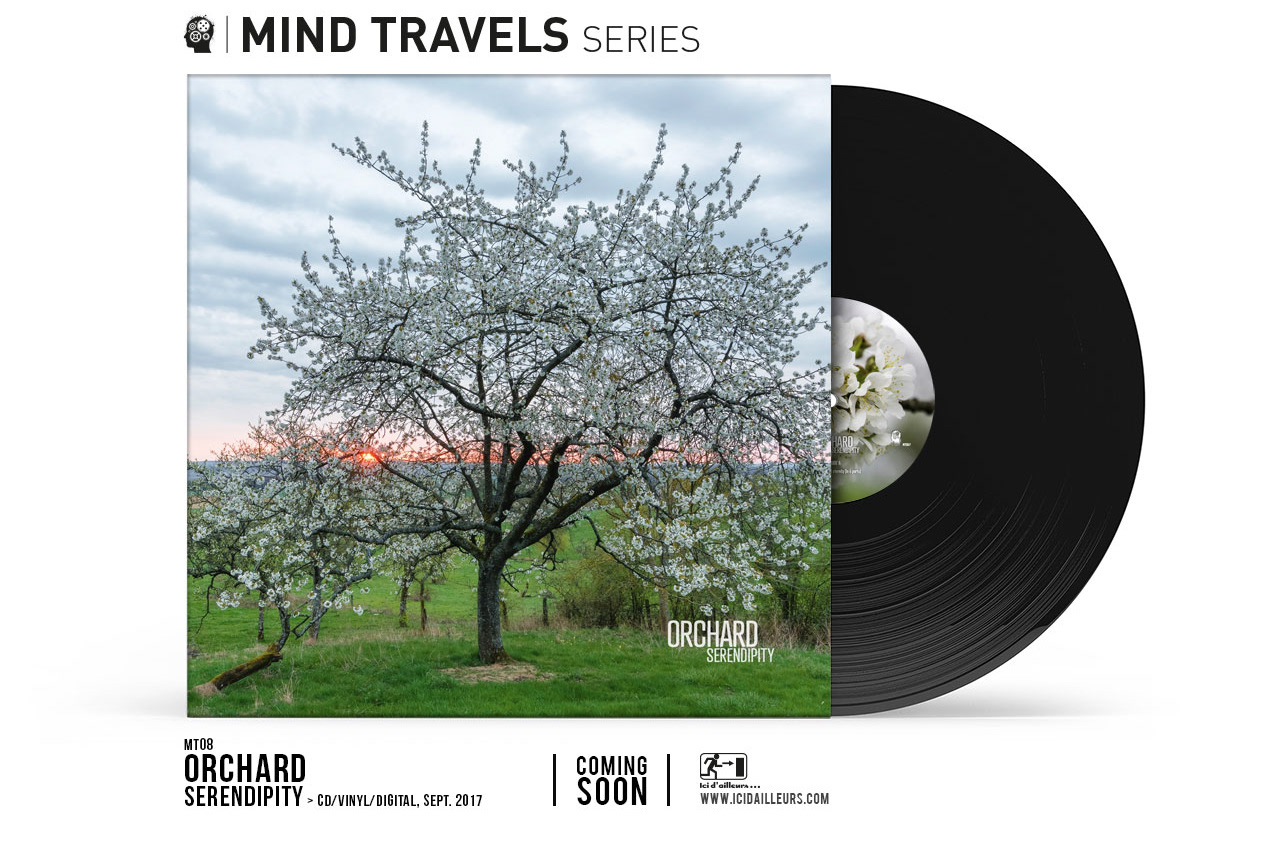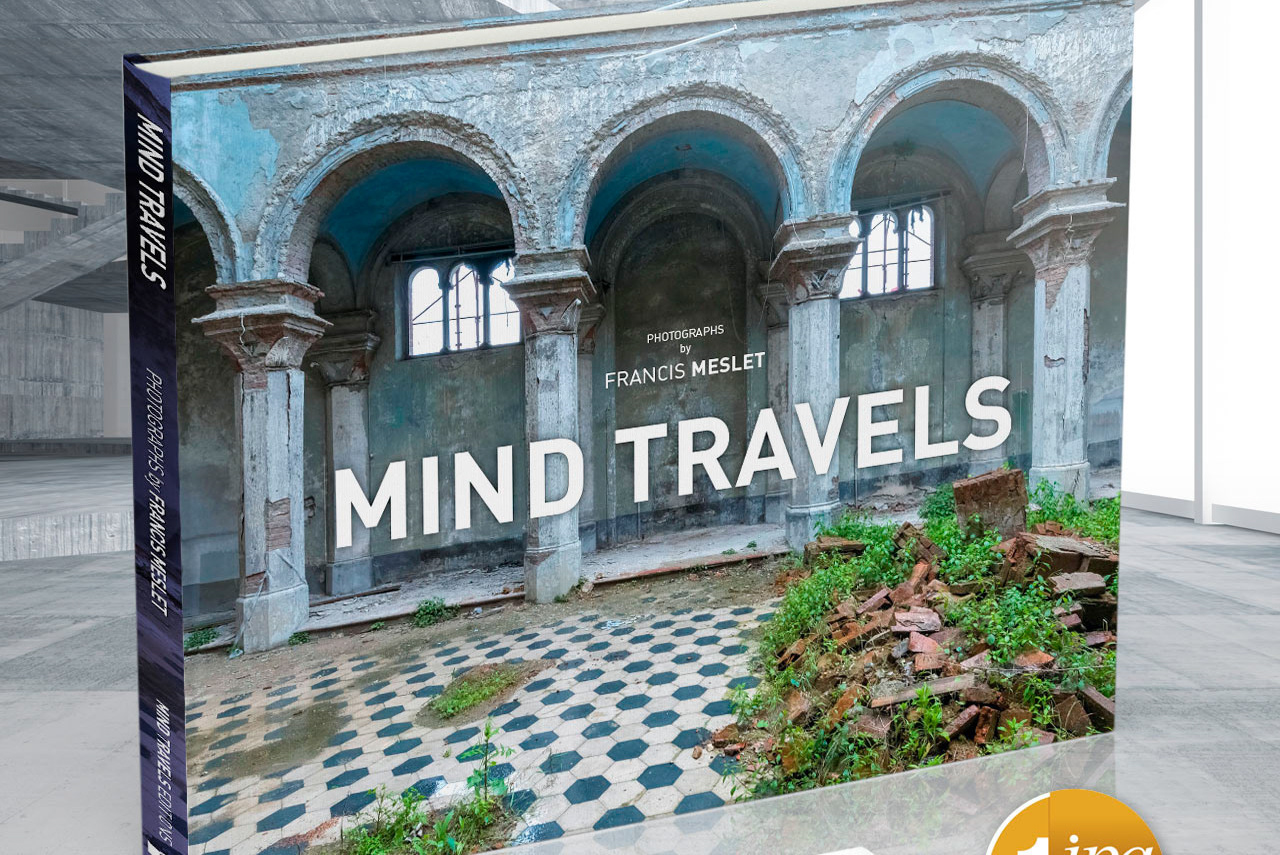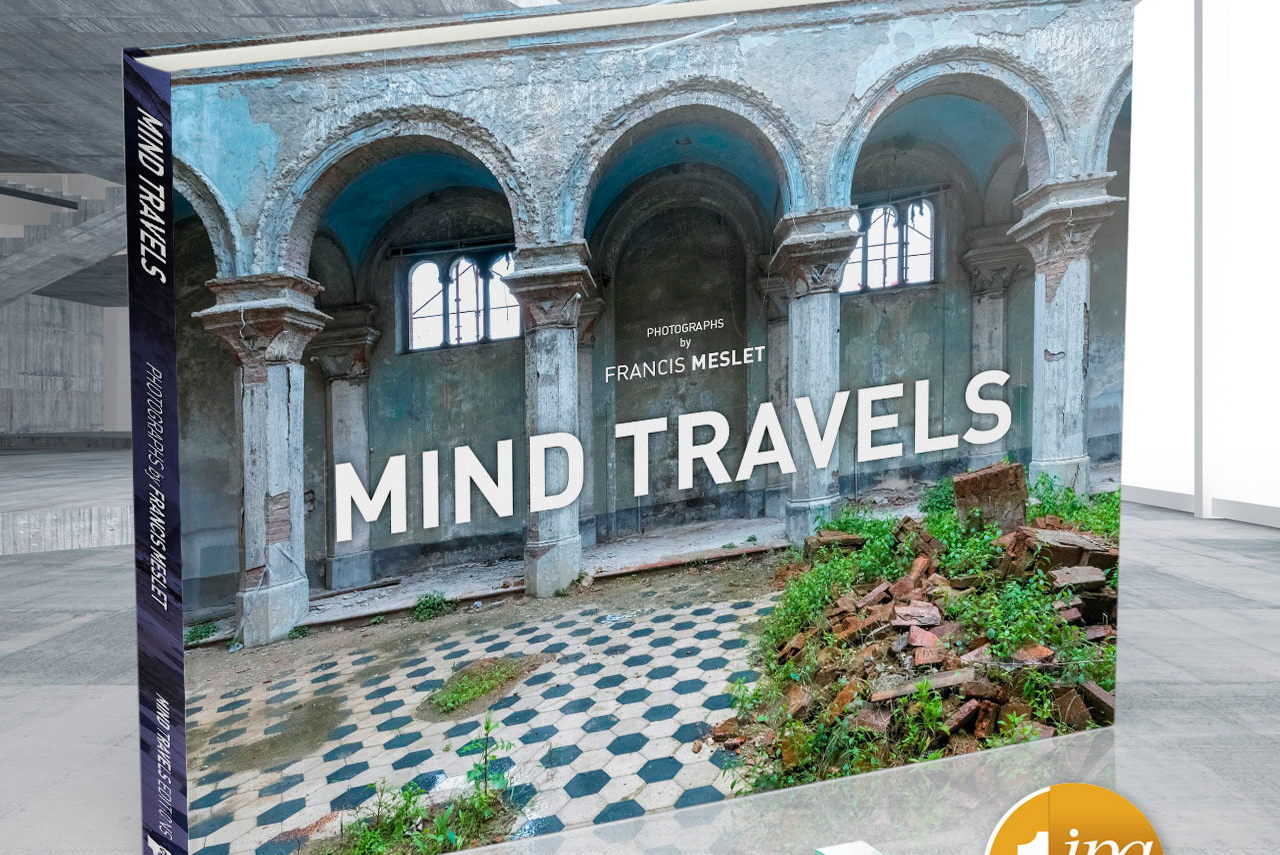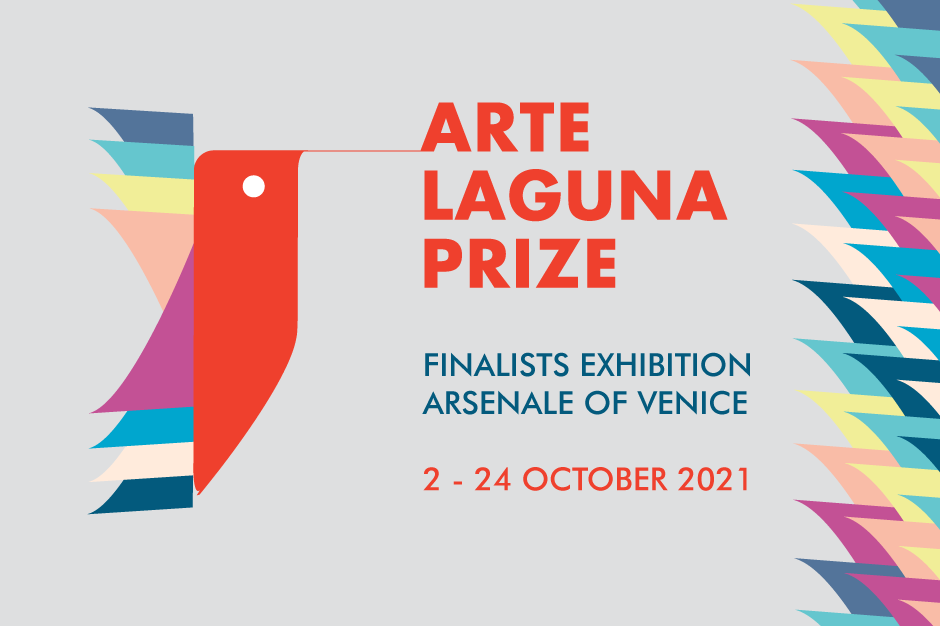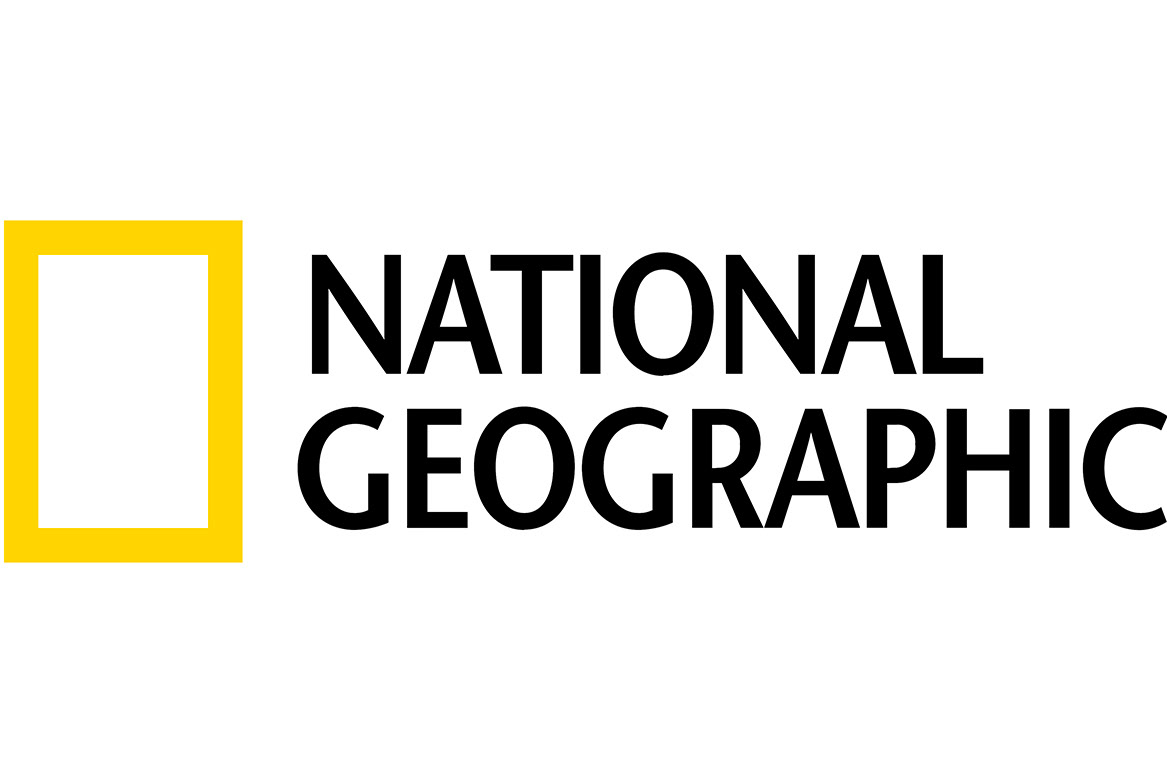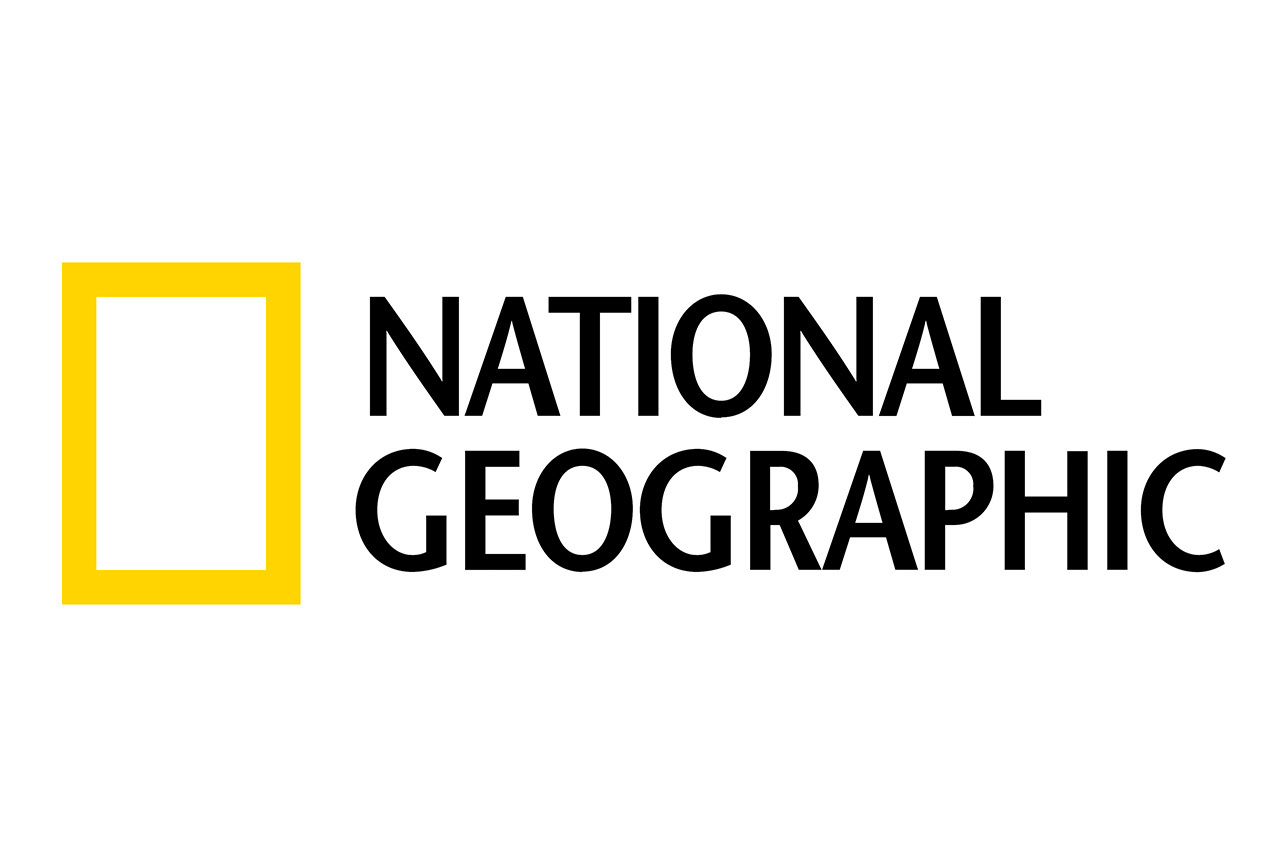Le créatif français Francis Meslet, photographe multi-primé à l’international, est une sorte de « grenouille de bénitier » de l’intelligence artistique… autant qu’artificielle (IA). Rendons grâce à son goût de l’imaginaire numérique allié aux jeux de mots : pour ce passionné de communication et d’identité visuelle c’est une marque de fabrique, ainsi que les titres de ses oeuvres en témoignent. Également designer diplômé de l’École Supérieure d’Arts de Nancy en 1986, il est auteur de trois livres photographiques dont l’un est consacré à notre sujet : Églises abandonnées – Lieux de culte en déshérence, publié en octobre 2020 (Ed. Jonglez), puis traduit en cinq langues. Son travail est largement et régulièrement diffusé dans le monde à travers la presse, la télévision et les expositions. " Exploration d’un monde abandonné par l'intelligence artificielle " (octobre 2024, Jonglez) est le tout premier livre urbex assisté avec l’IA.
C'est à votre tour de nous décrire votre premier coup de coeur "sacré" ?
Mon premier coup de coeur “sacré” date de 2013. Alors en trip urbex en Italie, je traçais sur une petite route de campagne italienne quand j’ai remarqué sur le côté de la route la flèche brisée d’un clocher dépassant d’un immense bosquet de végétation sauvage. Une image surréaliste qui reste encore gravée dans ma mémoire aujourd’hui. De jour, la vue extérieure était assez incroyable. Après avoir fait le tour, je me suis engagé dans un labyrinthe d’épines et au bout d’une dizaine de minutes j’ai pu accéder à une zone légèrement dégagée pour découvrir un accès étroit dans un mur de briques rouges décati.
Vous avez publié un livre sur les lieux de culte en déshérence en 2020, comment est née cette idée et comment l’avez-vous mise en oeuvre ?
Après une dizaine d’années passées à arpenter ces territoires parallèles, j’ai été frappé par le nombre de lieux de culte désertés par leurs fidèles et davantage encore interpellé par la poésie qui en émanait, de la simple chapelle à la plus haute église. Rien qu’en France, en 2019 l’Observatoire du Patrimoine Religieux (OPR) recensait pas moins de 103 églises menacées ou fermées, 65 victimes d’actes de vandalisme, 20 incendiées... Une trentaine d’églises a été démolie depuis 2000.
Un rapport du même observatoire annonçait en 2012 que, sur un patrimoine religieux estimé à 100.000 édifices en France (2,8 en moyenne par commune pour 36.000 communes), plusieurs milliers pourraient disparaître d’ici 2030. Seuls 15.000 sont protégés au titre des Monuments Historiques. Dans le meilleur des cas, plusieurs dizaines d’églises sont vendues chaque année pour être transformées en habitations, centres de remise en forme, studios d’enregistrement, bibliothèques, maisons d’hôtes... J’ai même vu un projet de fast-food.
À un moment dans mon parcours, j’ai été amené à rechercher les histoires qui se cachaient derrière ces pierres et tenté de cerner les raisons de leur abandon. Cataclysmes, tremblements de terre incendies… la triste réalité dépasse aujourd’hui la fiction sous des formes parfois bien plus ordinaires. Avec des budgets restreints, nombre de petites communes n’ont plus les moyens d’entretenir leurs églises et dans certains cas le choix se porte plutôt sur la réparation de la toiture de l’école. Étendez ce constat à l’ensemble de l’Europe et vous aurez une idée des kilomètres qu’il me reste à parcourir.
En 2019, j’avais visité plus de 300 édifices religieux en Europe. Lors de mes premières expositions j’avais constaté le vif intérêt du public pour ce qu’il découvrait. Étant directeur artistique dans la communication et l’édition, j’ai imaginé un livre un peu spécial. Au moment d’en écrire les textes, la question s’est posée de savoir à qui il s’adressait. Il s’agissait avant tout d’un travail photographique destiné à partager mes émotions et questionnements. J’ai finalement demandé à une dizaine de personnes d’horizons variés de se prêter à un exercice de style descriptif. Je leur ai remis trois photos de lieux différents sans aucune information, avec la mission d’écrire 20 lignes sur chacune. Chacun d’entre eux n’a eu connaissance du résultat final, de l’identité et du travail des autres qu’au moment de la publication de ce livre.
French creative Francis Meslet, a multi-award winning international photographer, is a kind of ‘holy Joe’ of artistic intelligence... as well as artificial intelligence (AI). His taste for digital imagination is often combined with wordplay. For this communications and visual identity enthusiast, it is a trademark, as the titles of his works testify. He is also a designe who graduated from ENSAD Nancy in 1986, and is the author of three photography books, one of which is devoted to our subject: Abandoned Churches: Unclaimed Places of Worship, published in October 2020 (Ed. Jonglez), then translated into five languages. His work is widely and regularly broadcasted around the world through the press, television an exhibitions. "Abandoned world: An AI-Generated Exploration", (October 2024, Jonglez) is the very first AI-assisted urbex book.
Now it's your turn to describe about your first ‘sacred’ crush?
My first “sacred” crush was in 2013. While on an urbex trip in Italy, I was driving along a small Italian country road when I noticed the broken spire of a bell tower protruding from a huge thicket of wild vegetation on the side of the road. It was a surreal image that remains engraved in my memory. By day, the view outside was quite incredible. After walking around, I entered a maze of thorns and after about ten minutes I reached a slightly open area to discover a narrow entrance in a decaying red brick wall.
You published a book on deserted places of worship in 2020. How did you come up with the idea and how did you go about it?
After ten years or so spent surveying these parallel territories, I was struck by the number of deserted spots, and even more by the poetry that emanated from them, from the simplest chapel to the bigger church. In France alone, in 2019, the Observatory of Religious Heritage counted no fewer than 103 churches threatened or closed, 65 targets of acts of vandalism, 20 set on fire... Some 30 churches have been demolished since 2000. In 2012, a report by the same observatory announced that, out of an estimated 100,000 religious buildings in France (an average of 2.8 per commune for a total of 36,000), several thousand could disappear by 2030. Only 15,000 are protected as Historic Monuments. In a best-case scenario, several dozen churches are sold each year to be converted into homes, fitness centres, recording studios, libraries, guest houses, etc. I’ve even seen a fast-food project.
At some point in my career, I was led to seek out the stories behind these stones and try to pinpoint the reasons for their abandonment. Cataclysms, earthquakes, fires... today’s sad reality goes beyond fiction, sometimes in much more ordinary ways. With limited budgets, many small towns no longer have the means to maintain their churches, and in some cases the choice is instead to repair the school roof. Extend this observation to the whole of Europe and you’ll have an idea of the miles I still have to cover.
By 2019, I had visited more than 300 religious buildings in Europe. During my first exhibitions, I noted the public’s keen interest in what they were discovering. As an art director in communications and publishing, I came up with a rather special book. When it came to writing the text, the question arose of who it should be aimed at. It was primarily a photographic work intended to share my emotions and questions. In the end, I asked a dozen people from different backgrounds to take part in an exercise in descriptive style. I gave them three photos of different places without any information and asked them to write 20 lines about each one. Each of them was unaware of the result, the identity and the work of the others, until the book was published.
Avez- une anecdote sur l’une de vos découvertes d’ex-lieux religieux ?
Un matin de 2015 j’avais pris des photos dans un château abandonné en France avec une magnifique petite chapelle et une ancienne abbaye juste à côté. Deux ans plus tard, remontant d’un trip urbex dans le sud de la France avec trois amis photographes belges et hollandais, nous sommes passés non loin de ce château. Mes collègues ont fortement insisté pour le tenter malgré mes réticences, j’ai fini par céder et nous sommes passés par la porte des cuisines qui était étonnement ouverte. Au milieu du couloir, je suis tombé nez à nez avec le couple de propriétaires furieux, qui m’a hurlé dessus en me traitant de vandale et de toutes sortes de noms d’oiseaux. Attirés par les bruits, mes amis m’ont rejoint, se trouvant à leur tour pris à partie par le couple. Etant le seul francophone, j’ai pris la situation en main et je suis parvenu, au bout de 20 minutes, à les convaincre que nous étions bienveillants et simplement curieux et passionnés.
L’idée m’est venue de leur proposer mes photos pour monter un dossier d’aide à la Fondation du Patrimoine. Ils m’ont fait clairement comprendre qu’ils n’en avaient strictement rien à faire. Entre-temps, ils avaient alerté leur ami et son boxer mâle agressif – qui se trouvait être un commissaire de police à la retraite. Là encore, j’ai dû parlementer pour l’assurer de notre bonne foi, photos et vidéos à l’appui. Il s’est contenté de relever mes coordonnées et nous a laissé partir. Une semaine plus tard, j’ai reçu un appel de la propriétaire pour me demander des photos de son château, que je lui ai envoyé dans la foulée. Finalement, ma proposition avait fait son chemin puisque, non sans m’avoir chaudement remercié et félicité, elle a monté son dossier de financement avec mes images. Le domaine en question a fini par s’ajouter à la liste des sites répertorié par la Fondation et le Loto du patrimoine et a reçu une aide conséquente pour sa restauration. Depuis, je suis devenu officiellement photographe bénévole pour la Fondation en proposant des portfolios de lieux en péril.
En 2023, cette dernière a édité un livre avec mes images réalisées en Bourgogne Franche-Comté. Mon travail figure dans plusieurs de ses campagnes d’affichage nationales mais je n’ai jamais touché ni demandé de droits d’auteurs.
Dans certaines de vos compositions, la frontière entre le réel et le fictif n’est pas évidente… Peut-on encore parler d’urbex ?
Il faut distinguer deux choses : le post traitement des images entièrement photographiques d’une part et les créations digitales empreintes d’IA d’autre part. Dans le premier cas, mon souci a toujours été de rester le plus fidèle possible à ce que mes yeux avaient découvert sur place. Du réalisme découle la beauté et la poésie de ces lieux abandonnés. Dans le cas de créations digitales et d’IA je me suis attaché à garder le même point de vue, cherchant à reproduire au plus proche le style de mon propre catalogue photographique : sujets, appréhension de l’espace, angles de vue, lumière, détails, couleurs… On peut même dire que mon travail avec l’IA s’inscrit dans la continuité directe de mon travail. Le bon dosage, en ce qui me concerne, consiste à ne pas trahir mon style photographique. C’est dans la créativité et la mise en situation des lieux abandonnés que je trouve ma satisfaction avec l’IA.
Sur divers réseaux, on observe une recrudescence de photos générées avec l’IA pour illustrer des histoires totalement fantaisistes s’agissant d’endroits et de faits qui n’ont jamais existé... que dans la tête de leurs inventeurs ! En tant qu’expert de l’image, que nous conseilleriez-vous pour démêler le faux du vrai ?
Il est permis de se raconter des histoires. Ce qui n’est pas permis c’est de tromper celui qui regarde dans le but de gagner des likes ou des abonnés. C’est le grand travers des réseaux sociaux. Se faire mousser rapidement, sans efforts et à moindre frais. Il faut que les gens réalisent ce qu’ils regardent. C’est comme en littérature, il y a la réalité et la fiction. La fiction n’enlève rien à la poésie ou aux qualités littéraires d’un texte. La prolifération des images deep-fake est une véritable plaie pour l’information et la notion même de vérité. Souhaitons qu’elle amène les utilisateurs à travailler leur discernement et qu’elle oblige nos enfants à vérifier et comparer les sources d’une information pour se faire leur propre opinion. En urbex particulièrement il y a beaucoup de mythomanes. Pour ma part, j’utilise dans mes publications digitales les mots clés #generativeart art #digitalpainting #aiartwork #aiartcommunity #aiart pour faire le distinguo.
Voici mes conseils : pour savoir si une image est vraie, renseignez-vous d’abord sur son auteur ou sur celui qui l’a publié. Ne prenez pas ce qu’on vous montre pour argent comptant. Laissez-vous aussi séduire par une image générée par IA sans pour autant alimenter une cabale anti-IA. L’IA prend toute sa place, il va falloir faire avec et il est grand temps d’en tirer parti dans nos métiers et notre vie plutôt que de la dénigrer systématiquement.
Avez-vous de prochains projets d’exposition, éditions ou voyages ?
Des projets d’exposition toujours, oui. Ma dernière grosse exposition date de septembre 2024. Plus de 90 tirages grand format sur deux niveaux dans une ancienne centrale électrique réhabilitée en espace culturel, pendant la Biennale Internationale de la Photographie à Épinal (88). Récemment j’ai eu quelques soucis de santé qui m’ont contraint à me calmer temporairement. Actuellement, je reprends lentement des forces et je n’ai qu’une hâte… repartir sur les routes.
Can you tell us a story about one of your discoveries of former religious sites?
One morning in 2015 I took photos in an abandoned château in France with a magnificent little chapel and an old abbey right next door. Two years later, coming back from an urbex trip in the south of France with three Belgian and Dutch photographer friends, we passed by this castle. My colleagues insisted on giving it a try. Despite my reluctance, I finally gave up and we went in through the kitchen door, which was surprisingly open. In the middle of the corridor, I came face to face with the furious owner couple, who screamed at me, calling me a vandal and all sorts of dirty names. Attracted by the noise, my friends joined me, only to find themselves also verbally attacked by the couple. Being the only French speaker, I took charge of the situation and, after 20 minutes, managed to convince them that we were simply harmless, curious and passionate guys.
I came up with the idea of offering them my photos to register for the Heritage Foundation. They made it clear that they absolutely did not care. Meanwhile, they had alerted their friend who showed up with his aggressive male boxer – the man just happened to be a retired police commissioner. Once again, I had to negotiate to assure him of our good faith, with photos and videos to back it up. He simply took down my details and let us go.
A week later, I received a call from the owner asking for photos of her castle, which I sent her straight away. In the end, my proposal was accepted and, after thanking me warmly and congratulating me, she put together a funding package using my images. Her estate was finally added to the sites listed by the Foundation and the Heritage Lottery and received substantial money for its restoration. Since then, I have become an official benevolent photographer for the Foundation, submitting portfolios of sites at risk.
In 2023, the Foundation published a book of my images taken in Burgundy Franche-Comté. My work has been featured in several of the Foundation’s national poster campaigns, but I have never received or requested any royalties.
In some of your work, the boundary between the real and the fictitious is not obvious... Can we still talk about urbex?
You have to distinguish between two things: the post-processing of entirely photographic images on the one hand and the digital creations with AI assistance on the other. In the first case, my concern has always been to remain as faithful as possible to what my eyes discovered on the spot. Realism gives these abandoned places their beauty and poetry. In the case of digital creations and AI, I have endeavoured to maintain the same point of view, seeking to reproduce as closely as possible the style of my own photographic catalogue: subjects, understanding of space, angles of view, light, details, colours... You could even say that my work with AI is a direct continuation of my own work. The right balance, as far as I’m concerned, is not to betray my photographic style. It’s in the creativity and the setting of abandoned places that I find my satisfaction with AI.
On various networks, we see an upsurge in photos generated using AI to illustrate totally fanciful stories about places and events that never existed... except in the minds of their inventors! As an image expert, what would you advise us to do to sort out the fake from the real?
You can tell yourself stories. What is not allowed is misleading the viewer to gain likes or followers. It’s the great flaw in social networking. Getting yourself noticed quickly, effortlessly and cheaply. People must realise what they are looking at. It’s like in literature, there’s reality and fiction. Fiction takes nothing away from the poetry or literary qualities of a text. The proliferation of deep-fake images is a real blight on information and the very notion of truth. Let’s hope it encourages users to develop their discernment and that it forces our children to check and compare the sources of information to form their own opinions. In urbex, there are a lot of mythomaniacs. For my part, I use the keywords: #generativeart #digital_art #digitalpainting #aiartwork #aiartcommunity #aiart in my digital publications to make the distinction.
Here's my advice: to find out if an image is real, first find out who created it or who published it. Don’t take what you see at face value. You can also be seduced by an AI-generated image without fuelling an anti-AI cabal. AI is coming into its own, we’re going to have to deal with it, and it’s high time we took advantage of it in our jobs and our lives rather than systematically denigrating it.
Do you have any future exhibition, publishing or travel projects?
Always exhibition projects, yes. My last big exhibition was in September 2024. More than 90 large-format prints on two levels in an old power station converted into a cultural space, during the International Photography Biennial in Épinal. Recently I’ve had a few health problems that have forced me to take it easy for a while. Now I’m slowly regaining my strength, and I can’t wait to get back out on the road.
DISPONIBLE / AVAILABLE
1er prix du Prix Paris Photo 2021 cat. Livre d'art, Nouveau Talent,
Médaille d'argent aux Tokyo Foto Awards 2020,
Mention honorable aux International Photo Awards,
Auteur & photographe : Francis Meslet
Paru : en novembre 2020
Pages : 224
Format : 305 x 215 mm
ISBN : 978-2-36195-441-3
Prix : 35 €
Contact : infos@editionsjonglez.com
www.https://jonglezpublishing.com
Médaille d'argent aux Tokyo Foto Awards 2020,
Mention honorable aux International Photo Awards,
Auteur & photographe : Francis Meslet
Paru : en novembre 2020
Pages : 224
Format : 305 x 215 mm
ISBN : 978-2-36195-441-3
Prix : 35 €
Contact : infos@editionsjonglez.com
www.https://jonglezpublishing.com
Entre 2012 et 2020, Francis Meslet a photographié plus d'une centaine de personnes à travers l'Europe. Ces endroits ont fait place au silence au fil du temps. Là, je comprends que le bruissement du vent est englouti par un verre brisé ou le rythme régulier d'une goutte d'eau ici perle au plafond d'une nef détruite. Ces silences plaisent aux rares visiteurs. Dans ce livre, les premiers ont été récités en latin, dans le collège catholique français, les enfants des enfants résonnent au son de la cloche. Pourrais-je jamais imaginer leurs fils enfouis derrière les murs de ces cryptes au cœur des montagnes italiennes ou dans les tombeaux de cet ancien pays du Portugal ?
Francis Meslet parcourt le monde pendant six heures perdues, à la recherche de lieux en déshérence, de sanctuaires sur lesquels le temps s'est arrêté après que l'homme à la porte a fermé les portes. Le souvenir des images merveilleuses, capsules temporelles d'un univers parallèle propice à l'évasion de l'esprit et à l'interrogation... Avec le plus grand respect des fidèles ici, nous proposons une immersion dans les choses qui furent désertées, à la recherche d'une lumière divine.
1st Prize at Paris Photo Prize 2021 cat. Fine Art Book, New Talent,
Silver Prize at Tokyo Foto Awards 2020,
Mention of honnor at International Photo Awards,
Author & photographer : Francis Meslet
Publication: novembre 2020
Pages : 224
Format : 305 x 215 mm
ISBN : 978-2-36195-441-3
Price : 35 € - 36 € (A) - 39,95 $ US - 29,95 £
Contact : infos@jonglezpublishing.com
www.jonglezpublishing.com
Silver Prize at Tokyo Foto Awards 2020,
Mention of honnor at International Photo Awards,
Author & photographer : Francis Meslet
Publication: novembre 2020
Pages : 224
Format : 305 x 215 mm
ISBN : 978-2-36195-441-3
Price : 35 € - 36 € (A) - 39,95 $ US - 29,95 £
Contact : infos@jonglezpublishing.com
www.jonglezpublishing.com
Between 2012 and 2019 Francis Meslet photographed several hundred places of worship across Europe. Over time, these places have became enveloped in silence, the only thing heard there now an occasional gust of wind whistling though broken stained glass, or the rhythmic drip of water leaking through the dilapidated roof above a nave. Nevertheless, these muted places still draw an occasional visitor. Once upon a time, prayers could be heard recited in Latin in a German church; and in a French Catholic college, the voices of children once resounded to the sound of the bells. But who can imagine what sounds might be concealed behind the walls of a crypt in the heart of the Italian mountains, or within a tomb in a former convent in Portugal?
In his spare time Francis travels the world in search of places that have fallen into disuse - religious buildings where time has stood still since their doors were closed for the last time. He returns with incredible photographs, each a time capsule, a record of a parallel universe. They prompt us to let our imaginations wander and ask ourselves questions. With the greatest respect for the faithful who regularly visited them long ago, he offers us an opportunity to immerse ourselves in places that have been abandoned by faith, to seek a divine light.
In his spare time Francis travels the world in search of places that have fallen into disuse - religious buildings where time has stood still since their doors were closed for the last time. He returns with incredible photographs, each a time capsule, a record of a parallel universe. They prompt us to let our imaginations wander and ask ourselves questions. With the greatest respect for the faithful who regularly visited them long ago, he offers us an opportunity to immerse ourselves in places that have been abandoned by faith, to seek a divine light.
> 23 octobre 2024
ISBN : ISBN: 978-2-36195-797-1
256 pages - FORMAT : 235 x 305 mm
Éditions JONGLEZ
ISBN : ISBN: 978-2-36195-797-1
256 pages - FORMAT : 235 x 305 mm
Éditions JONGLEZ
Fort de quinze années d’exploration urbaine en tant que photographe de la poésie des ruines, à l’aide de l’intelligence artificielle, Francis Meslet nous emmène dans la découverte d’un monde abandonné dans un futur pas si lointain. La végétation qui reprend ses droits dans les plus grandes bibliothèques désertées d’Europe, les ruines à ciel ouvert des plus beaux théâtres, les vestiges des grandes industries à l’arrêt, Paris sous la végétation ou les ruines de Notre-Dame qui n’aurait pas été sauvée des flammes...Le travail de Francis est bien plus qu’une simple documentation iconographique imaginaire. C’est une tentative de réconciliation entre le futur et le passé, une méditation sur la fragilité de la mémoire collective. Chasseur d’instants éphémères, ses images d’art-génératif révèlent la dualité du temps, la coexistence du déclin et de l’éclat. Avec son regard aiguisé, il s’invente poète de la décrépitude, capturant l’âme de la négligence, faisant de chaque image un cri silencieux dans le désert de l’indifférence contemporaine..
> 23rd of october 2024
ISBN : 978-2-36195-682
256 pages - FORMAT : 235 x 305 mm
JONGLEZ Publishing
ISBN : 978-2-36195-682
256 pages - FORMAT : 235 x 305 mm
JONGLEZ Publishing
Drawing on fifteen years of urban exploration, with the help of artificial intelligence, Francis Meslet, a photographer of the poetry of ruins, takes us on a journey of discovery through anabandoned world in the not-so-distant future. Plant life reclaiming its rights in Europe’s largest deserted libraries; the open-air ruins of the finest theaters; the remains of major decommissioned industrial facilities; Paris overgrown with vegetation; and the ruins of Notre-Dame, which couldn’t be saved from the flames … Francis’s work is much more than just the iconographic documentation of an imagined world.It is an attempt to reconcile the future and the past, a meditation on the fragility of collective memory. A hunter of ephemeral moments, his generative art images reveal the duality of time, the coexistence of decline and radiance. With his sharp eye, he is a poet of decrepitude, capturing the soul of neglect and making each image a silent cry in the desert of contemporary indifference.
CONTACTEZ-MOI / CONTACT ME
Merci pour votre intérêt.


